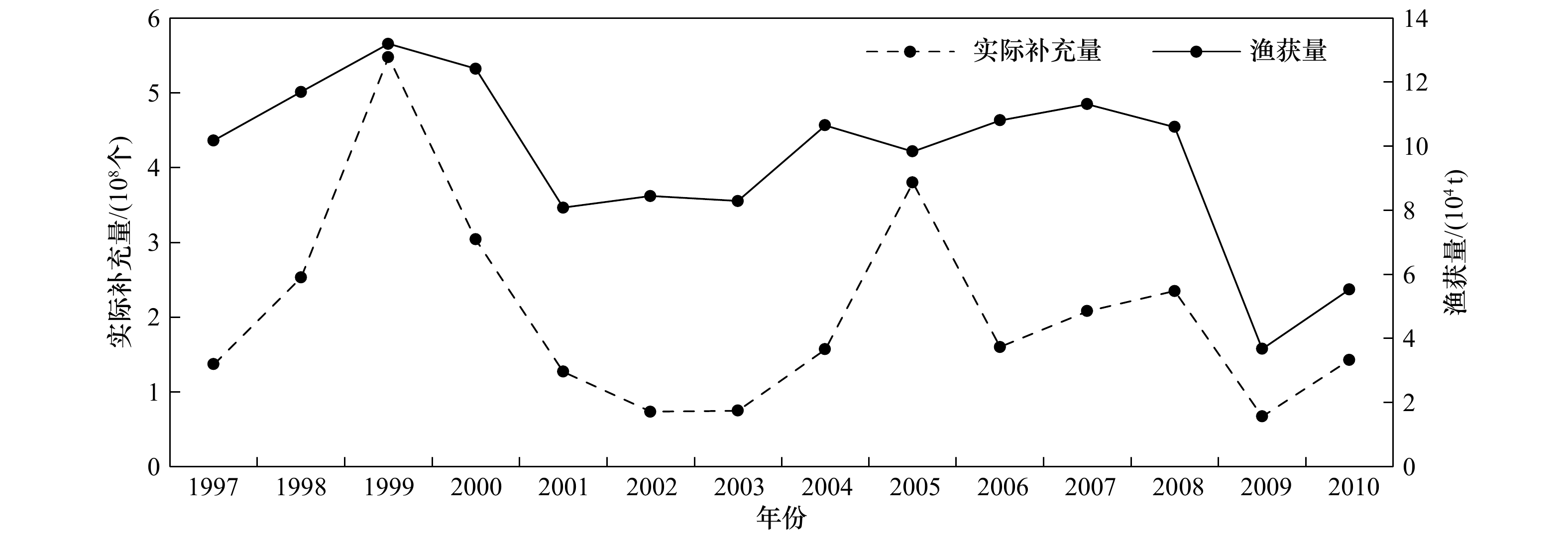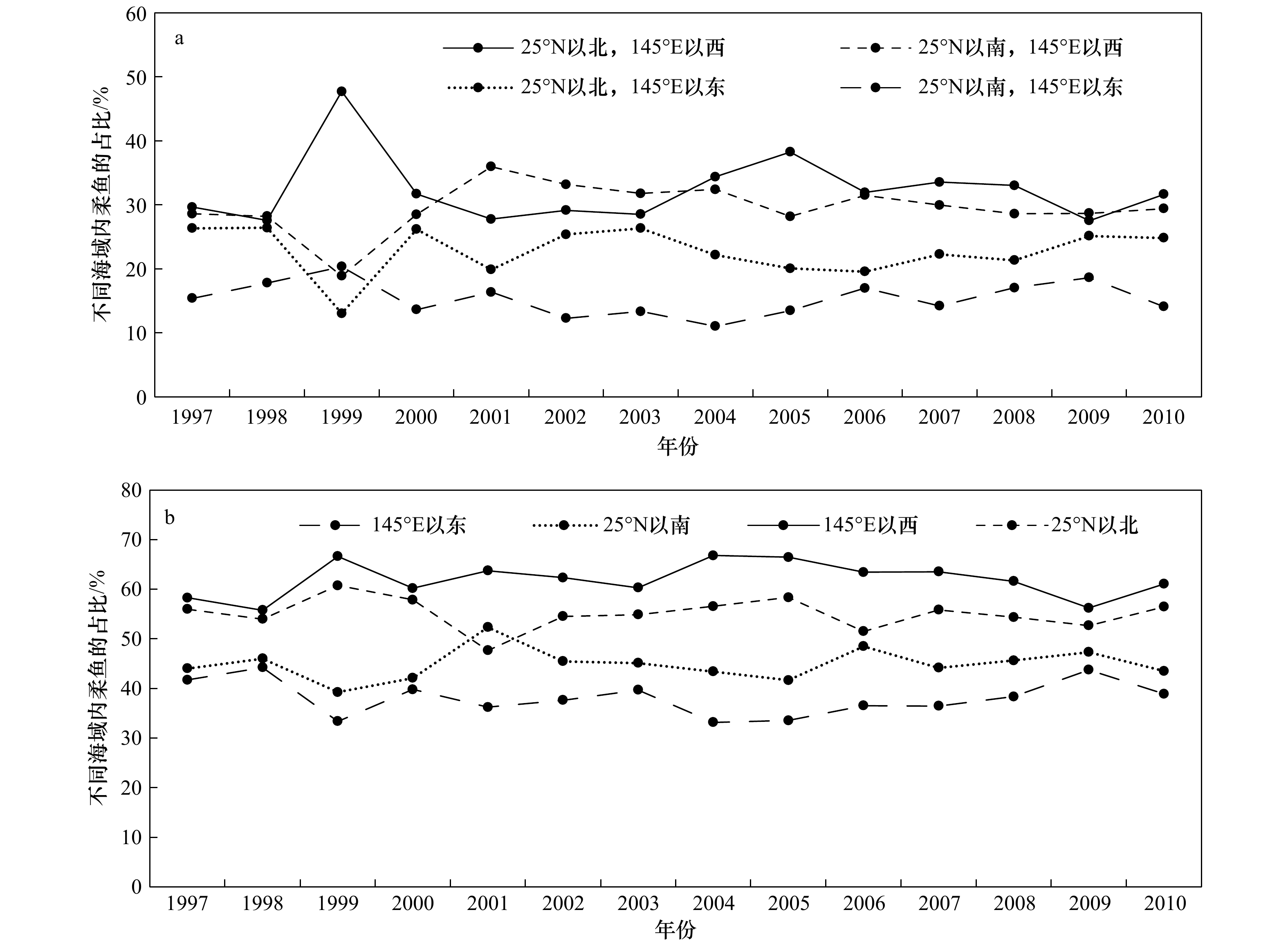Construction of individual-based ecological model of early life history of winter-spring cohort of neon flying squid Ommastrephes bartramii in the Northwest Pacific Ocean
-
摘要: 为了对西北太平洋柔鱼冬春生群生活史早期的生长、死亡、输运和分布等进行研究,将其生长、死亡等早期生物过程进行参数化,利用物理模型(FVCOM-Global)模拟生成北太平洋(10°~60°N,120°E~110°W)三维物理场,采用拉格朗日质点追踪的方法将物理模型和生物模型(基于个体模型)耦合,构建了基于个体的西北太平洋柔鱼冬春生群生活史早期生态模型,并用此模型对1997–2010年冬春生群的输运分布进行数值模拟。模拟结果表明:在一定温度范围内,越靠近最适水温,冬春生群的生长速度越快,当日龄为38 d时,胴长可达到11.76 mm,之后由指数生长逐渐变为线性生长;1997–2010年模拟补充量有年际的波动,在考虑冬春生群亲体量不同的前提下得到的实际补充量最多和最少的年份分别是1999年和2009年;冬春生群在模拟阶段主要位于产卵场内,在25°N以南主要向西部输运,25°N以北逐渐呈向北和向东北方向输运的趋势,尤其在输运后期受强流的影响较大;在垂直方向上,100 m水深以内的仔鱼占比将近一半。本研究能为西北太平洋柔鱼冬春生群的生态动力学深入研究奠定基础。Abstract: In order to study the growth, death, transport and distribution of early life history of winter-spring cohort of neon flying squid Ommastrephes bartramii in the Northwest Pacific Ocean, parameterized early biological processes, such as growth and death. Used the physical model (FVCOM-Global) to simulate and generate three-dimensional physical field of the North Pacific Ocean (10°−60°N, 120°E−110°W), and adopted the Lagrangian particle tracking method to couple the physical model and the biological model (individual-based model), and constructed an individual-based ecological model of early life history of winter-spring cohort of O. bartramii in the Northwest Pacific Ocean, and used this model to numerically simulate the transport distribution of winter-spring cohort from 1997 to 2010. The simulation results showed that within a certain temperature range, the closer to the optimum water temperature, the faster the growth rate of winter-spring cohort. When the age was 38 days, the mantle length could reach 11.76 millimeters, and then gradually changed from exponential growth to linear growth. The simulative recruitment had interannual fluctuation from 1997 to 2010. Considering the different number of winter-spring cohort parents, the years with the most and the least actual recruitment were 1999 and 2009, respectively. In the simulation stage, the winter-spring cohort was mainly located in the spawning ground, transported to the west in the south of 25°N, and gradually transported to the north and northeast in the north of 25°N, especially affected by the strong current in the later period of transport. In the vertical direction, the larvae within 100 meters water depth accounted for nearly half. This study can lay a foundation for further study of ecological dynamics of winter-spring cohort of O. bartramii in the Northwest Pacific Ocean.
-
表 1 补充量和渔获量
Tab. 1 Recruitment and catch
年份 模拟补充量/
(108个)渔获量/t 系数 实际补充量/
(108个)1997 1.29 101 839 1.06 1.37 1998 2.07 117 000 1.22 2.53 1999 4 132 000 1.37 5.48 2000 2.36 124 204 1.29 3.04 2001 1.51 80 873 0.84 1.27 2002 0.835 84 487 0.88 0.735 2003 0.873 82 949 0.86 0.751 2004 1.41 106 532.2 1.11 1.57 2005 3.73 98 372 1.02 3.8 2006 1.43 108 097.1 1.12 1.6 2007 1.76 113 117.6 1.18 2.08 2008 2.14 106 018.9 1.10 2.35 2009 1.77 36 763.7 0.38 0.673 2010 2.47 55 350.7 0.58 1.43 表 2 输运到四周最远的柔鱼相对于产卵场的距离
Tab. 2 The distance to spawning ground of the farthest neon flying squid Ommastrephes bartramii transported to the surrounding waters
年份 向北输运
的距离/km向南输运
的距离/km向西输运
的距离/km向东输运
的距离/km1997 388.50 234.21 366.89 387.57 1998 199.80 333.00 435.44 404.81 1999 902.43 401.82 466.48 192.41 2000 226.44 258.63 372.20 181.22 2001 730.38 279.72 488.65 452.75 2002 346.32 341.88 596.73 343.04 2003 222.00 347.43 363.39 293.87 2004 623.82 185.37 328.68 369.24 2005 342.99 337.44 302.35 550.79 2006 132.09 331.89 298.11 240.32 2007 136.53 293.04 365.90 269.21 2008 608.28 422.91 197.37 173.15 2009 142.08 255.30 487.30 297.70 2010 193.14 122.10 483.08 405.86 表 3 整个模拟阶段内冬春生群分布在不同水深处的比例(%)
Tab. 3 The proportion of winter-spring cohort distributed in different water depths during the whole simulation stage(%)
水深/m 1997年 1998年 1999年 2000年 2001年 2002年 2003年 2004年 2005年 2006年 2007年 2008年 2009年 2010年 0~100 44.54 50.01 32.18 46.11 56.59 49.88 48.42 49.62 43.00 53.71 51.79 45.46 47.89 50.51 100~200 27.58 25.96 18.95 28.50 22.86 27.94 27.64 23.56 28.67 23.20 25.89 26.95 25.93 24.54 200~300 10.85 8.46 9.68 9.00 6.18 7.80 8.54 7.88 8.12 6.82 7.00 8.03 8.16 8.11 300~400 4.03 2.52 5.93 3.22 2.54 2.96 3.16 3.73 3.42 3.44 2.69 3.70 2.77 3.24 400~500 2.21 1.40 3.80 1.81 1.58 1.81 1.79 1.91 2.15 2.24 1.78 2.43 1.87 1.74 500~600 1.48 1.17 3.39 1.39 1.38 1.07 1.51 1.57 1.82 1.76 1.46 1.72 1.71 1.25 600~700 1.19 1.01 2.72 1.24 1.14 0.88 1.31 1.05 1.89 0.91 1.38 1.60 1.39 1.22 700~1 500 4.67 5.55 10.74 5.91 4.73 5.39 5.07 5.36 7.35 4.16 5.51 6.26 6.96 6.11 >1 500 3.45 3.92 12.61 2.82 3.00 2.27 2.56 5.32 3.58 3.76 2.50 3.85 3.32 3.28 -
[1] 余为. 西北太平洋柔鱼冬春生群对气候与环境变化的响应机制研究[D]. 上海: 上海海洋大学, 2016.Yu Wei. Response mechanism of winter-spring cohort of neon flying squid to the climatic and environmental variability in the Northwest Pacific Ocean[D]. Shanghai: Shanghai Ocean University, 2016. [2] 唐峰华, 伍玉梅, 樊伟. 北太平洋柔鱼生殖群体结构特征及繁殖生物学[J]. 中国海洋大学学报, 2011, 41(7): 72−78.Tang Fenghua, Wu Yumei, Fan Wei. Population structure and reproductive biology of mature neon flying squid in the North Pacific Ocean[J]. Periodical of Ocean University of China, 2011, 41(7): 72−78. [3] 马金, 陈新军, 刘必林, 等. 西北太平洋柔鱼耳石形态特征分析[J]. 中国海洋大学学报, 2009, 39(2): 215−220.Ma Jin, Chen Xinjun, Liu Bilin, et al. Morphologic features of statolith for Ommastrephes bartramii in the Northwest Pacific Ocean[J]. Periodical of Ocean University of China, 2009, 39(2): 215−220. [4] 金岳, 方舟, 李云凯, 等. 北太平洋东部柔鱼群体角质颚生长特性分析[J]. 海洋渔业, 2015, 37(2): 101−106. doi: 10.3969/j.issn.1004-2490.2015.02.001Jin Yue, Fang Zhou, Li Yunkai, et al. Growth characteristics analysis of Ommastrephes bartramii beaks in eastern North Pacific[J]. Marine Fisheries, 2015, 37(2): 101−106. doi: 10.3969/j.issn.1004-2490.2015.02.001 [5] 余为, 陈新军, 易倩, 等. 北太平洋柔鱼早期生活史研究进展[J]. 上海海洋大学学报, 2013, 22(5): 755−762.Yu Wei, Chen Xinjun, Yi Qian, et al. Review on the early life history of neon flying squid Ommastrephes bartramii in the North Pacific[J]. Journal of Shanghai Ocean University, 2013, 22(5): 755−762. [6] 陆化杰, 陈新军. 2006年北太平洋柔鱼作业渔场时空变化及其与表温的关系[J]. 广东海洋大学学报, 2008, 28(1): 93−97. doi: 10.3969/j.issn.1673-9159.2008.01.022Lu Huajie, Chen Xinjun. Catch distribution ofOmmastrephes batramii and its relationship with sea surface temperature in the North Pacific Ocean in 2006[J]. Journal of Guangdong Ocean University, 2008, 28(1): 93−97. doi: 10.3969/j.issn.1673-9159.2008.01.022 [7] 陈峰, 陈新军, 陆化杰, 等. 北太平洋中东部2个海区柔鱼生物学特性比较研究[J]. 上海海洋大学学报, 2011, 20(5): 759−764.Chen Feng, Chen Xinjun, Lu Huajie, et al. Comparison of biological characteristics of Ommastrephes bartarmii between two different areas in the east central waters of North Pacific Ocean[J]. Journal of Shanghai Ocean University, 2011, 20(5): 759−764. [8] 陈新军, 李曰嵩. 基于个体生态模型在渔业生态中应用研究进展[J]. 水产学报, 2012, 36(4): 629−640. doi: 10.3724/SP.J.1231.2012.27661Chen Xinjun, Li Yuesong. Review of application of individual-based model to fishery ecosystem[J]. Journal of Fisheries of China, 2012, 36(4): 629−640. doi: 10.3724/SP.J.1231.2012.27661 [9] Heath M R, Gallego A. Bio-physical modelling of the early life stages of haddock, Melanogrammus aeglefinus, in the North Sea[J]. Fisheries Oceanography, 1998, 7(2): 110−125. doi: 10.1046/j.1365-2419.1998.00061.x [10] Bartsch J, Brander K, Heath M, et al. Modelling the advection of herring larvae in the North Sea[J]. Nature, 1989, 340(6235): 632−636. doi: 10.1038/340632a0 [11] 李向心. 基于个体发育的黄渤海鳀鱼种群动态模型研究[D]. 青岛: 中国海洋大学, 2007.Li Xiangxin. Study on individual-based model of anchovy population dynamics in the Huanghai Sea and Bohai Sea[D]. Qingdao: Ocean University of China, 2007. [12] 李曰嵩. 东海鲐鱼(Scomber japonica)早期生活史过程的生态动力学模拟研究[D]. 上海: 上海海洋大学, 2012.Li Yuesong. Simulation study of ecological dynamics of early life history of Chub mackerel (Scomber japonicus) in the East China Sea[D]. Shanghai: Shanghai Ocean University, 2012. [13] 胡松, 陈长胜, 高郭平, 等. 全球非结构网格有限体积法海洋模式东中国海潮汐计算初步分析[J]. 上海海洋大学学报, 2012, 21(4): 621−629.Hu Song, Chen Changsheng, Gao Guoping, et al. Preliminary analysis of tide simulation of the East China Sea of the Global-FVCOM model[J]. Journal of Shanghai Ocean University, 2012, 21(4): 621−629. [14] 侍茂崇, 陈妍宇, 陈波, 等. 2007年夏季北部湾生态与环境要素分布规律研究[J]. 广西科学, 2019, 26(6): 614−625.Shi Maochong, Chen Yanyu, Chen Bo, et al. Study on the distribution rule of ecological and environmental elements in Beibu Gulf in summer of 2007[J]. Guangxi Sciences, 2019, 26(6): 614−625. [15] 李曰嵩, 陈新军, 杨红. 基于个体的东海鲐鱼生长初期生态模型的构建[J]. 应用生态学报, 2012, 23(6): 1695−1703.Li Yuesong, Chen Xinjun, Yang Hong. Construction of individual-based ecological model for Scomber japonicas at its early growth stages in East China Sea[J]. Chinese Journal of Applied Ecology, 2012, 23(6): 1695−1703. [16] 余为, 陈新军, 李曰嵩. 基于个体生态模型在渔业科学中的应用研究现状[J]. 海洋渔业, 2012, 34(4): 464−475. doi: 10.3969/j.issn.1004-2490.2012.04.015Yu Wei, Chen Xinjun, Li Yuesong. Review on individual-based model in fishery science[J]. Marine Fisheries, 2012, 34(4): 464−475. doi: 10.3969/j.issn.1004-2490.2012.04.015 [17] 方舟. 基于角质颚的北太平洋柔鱼渔业生态学研究[D]. 上海: 上海海洋大学, 2016.Fang Zhou. Fisheries ecology of neon flying squid Ommastrephes bartramii in North Pacific Ocean based on beak[D]. Shanghai: Shanghai Ocean University, 2016. [18] 刘金立. 西北太平洋柔鱼生物经济模型及管理策略评价[D]. 上海海洋大学, 2014. Liu Jinli. An evaluation of bio-economic models and management strategies for Ommastrephes bartramii in the Northwestern Pacific Ocean[D]. Shanghai: Shanghai Ocean University, 2014. [19] 王易帆, 陈新军. 西北太平洋柔鱼产卵场时空分布及最适水温范围的推测[J]. 上海海洋大学学报, 2019, 28(3): 448−455.Wang Yifan, Chen Xinjun. Suitable environmental conditions for spawning ground affecting the abundance of neon flying squid in northwestern Pacific Ocean[J]. Journal of Shanghai Ocean University, 2019, 28(3): 448−455. [20] 徐洁. 基于复合种群的短生命周期种类资源评估与管理——以西北太平洋柔鱼为例[D]. 上海: 上海海洋大学, 2015.Xu Jie. Stock assessment and manangement for metapopulation of short-lived species—a case of Ommastrephes bartramii in the northwest Pacific Ocean[D]. Shanghai: Shanghai Ocean University, 2015. [21] 陈新军. 北太平洋海域白天利用水下灯钓捕大型柔鱼的试验报告[J]. 上海水产大学学报, 2000, 9(2): 172−174.Chen Xinjun. Experiment on fishing large-sized squid with underwater light at daytime in the North Pacific[J]. Journal of Shanghai Fisheries University, 2000, 9(2): 172−174. [22] 陈新军, 曹杰, 田思泉, 等. 表温和黑潮年间变化对西北太平洋柔鱼渔场分布的影响[J]. 大连水产学院学报, 2010, 25(2): 119−126.Chen Xinjun, Cao Jie, Tian Siquan, et al. Effect of inter-annual change in sea surface water temperature and Kuroshio on fishing ground of squid Ommastrephes bartramii in the Northwest Pacific[J]. Journal of Dalian Fisheries University, 2010, 25(2): 119−126. [23] 马金, 陈新军, 刘必林, 等. 北太平洋柔鱼渔业生物学研究进展[J]. 上海海洋大学学报, 2011, 20(4): 563−570.Ma Jin, Chen Xinjun, Liu Bilin, et al. Review of fisheries biology of neon flying squid (Ommastrephes bartramii) in the North Pacific Ocean[J]. Journal of Shanghai Ocean University, 2011, 20(4): 563−570. [24] 魏广恩, 陈新军. 北太平洋柔鱼(Ommastrephes bartramii)资源渔场研究进展[J]. 广东海洋大学学报, 2016, 36(6): 114−122. doi: 10.3969/j.issn.1673-9159.2016.06.018Wei Guangen, Chen Xinjun. Review on neon flying squid (Ommastrephes bartramii) resources and fishing ground in the North Pacific Ocean[J]. Journal of Guangdong Ocean University, 2016, 36(6): 114−122. doi: 10.3969/j.issn.1673-9159.2016.06.018 [25] Murata M, Nakamura Y. Seasonal migration and Diel vertical migration of the neon flying squid, Ommastrephes bartramii in the North Pacific[C]//International Symposium on Large Pelagic Squids. Tokyo: Japan Marine Fishery Resources Research Center, 1998: 13−30. [26] Nakamura Y. The ecology of large sized squid with an emphasis on the diel vertical migration of Ommastrephes bartrami[J]. Aquabiology, 1995, 17(16): 475−481. [27] Bigelow K A, Landgraf K C. Hatch dates and growth of Ommastrephes bartramii paralarvae from Hawaiian waters as determined from statolith analysis[C]//Recent Advances in Cephalopod Fisheries Biology. Tokyo, Japan: Tokai University Press, 1993: 15−24. [28] 陈峰, 陈新军, 钱卫国, 等. 水温变动对2009年西北太平洋柔鱼产量下降的影响[J]. 广东海洋大学学报, 2010, 30(1): 65−71. doi: 10.3969/j.issn.1673-9159.2010.01.013Chen Feng, Chen Xinjun, Qian Weiguo, et al. Influence of variability of temperature on decline of catch for Ommastrephes bartramii in the Northwestern Pacific Ocean in 2009[J]. Journal of Guangdong Ocean University, 2010, 30(1): 65−71. doi: 10.3969/j.issn.1673-9159.2010.01.013 [29] Bartsch J, Coombs S H. An individual-based model of the early life history of mackerel (Scomber scombrus) in the eastern North Atlantic, simulating transport, growth and mortality[J]. Fisheries Oceanography, 2004, 13(6): 365−379. doi: 10.1111/j.1365-2419.2004.00305.x [30] Yatsu A, Mori J. Early growth of the autumn cohort of neon flying squid, Ommastrephes bartramii, in the North Pacific Ocean[J]. Fisheries Research, 2000, 45(2): 189−194. doi: 10.1016/S0165-7836(99)00112-5 [31] Nishikawa H, Igarashi H, Ishikawa Y, et al. Impact of paralarvae and juveniles feeding environment on the neon flying squid (Ommastrephes bartramii) winter-spring cohort stock[J]. Fisheries Oceanography, 2014, 23(4): 289−303. doi: 10.1111/fog.12064 [32] Bower J R. Spawning grounds of the neon flying squid, Ommastrephes bartramii, near the Hawaiian Archipelago[J]. Pacific Science, 1994, 48(2): 201. -





 下载:
下载:













